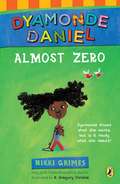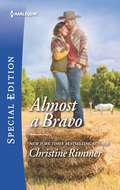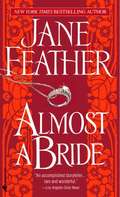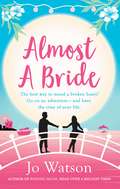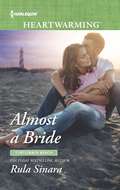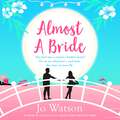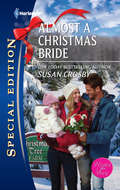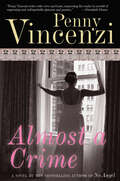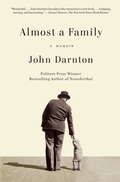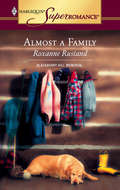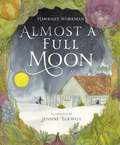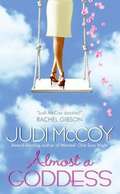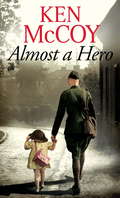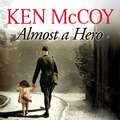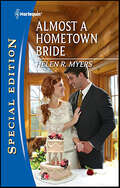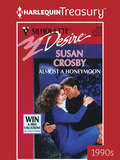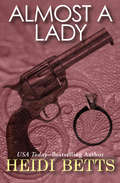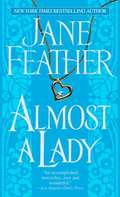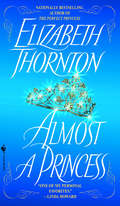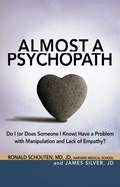- Table View
- List View
Almost Zero
by Nikki Grimes R. Gregory ChristieDyamonde really wants red high-top sneakers. Too bad they're so expensive! A classmate tells her it's her mom's job to give her what she needs, but when Dyamonde tries that argument, her mom teaches her a lesson by literally only giving her what she needs. Now Dyamonde is down to almost zero outfits! But then she finds out one of her friends has it much worse, and she's determined to do what she can to help. Coretta Scott King Award winner Nikki Grimes' third book starring the unstoppable Dyamonde Daniel will delight fans and new readers alike, with energetic storytelling, relatable situations and Dyamonde's spitfire personality.
Almost Zero
by Nikki Grimes R. Gregory Gregory ChristieDyamonde really wants red high-top sneakers. Too bad they're so expensive! A classmate tells her it's her mom's job to give her what she needs, but when Dyamonde tries that argument, her mom teaches her a lesson by literally only giving her what she needs. Now Dyamonde is down to almost zero outfits! But then she finds out one of her friends has it much worse, and she's determined to do what she can to help. Coretta Scott King Award winner Nikki Grimes' third book starring the unstoppable Dyamonde Daniel will delight fans and new readers alike, with energetic storytelling, relatable situations and Dyamonde's spitfire personality.
Almost a Bravo (The Bravos of Valentine Bay #2)
by Christine RimmerShe isn’t a true Bravo—And now she’s inheriting a temporary husband! It’s shocking enough discovering she was switched at birth. Now, to fulfill the terms of his adoptive father’s will, Aislinn Bravo must marry Jaxon Winter or he loses his beloved ranch. Living together as husband and wife for three months only deepens Aislinn’s desire for her longtime crush. But how can she dream of a future with Jax when her whole life is a lie?
Almost a Bride
by Jane FeatherIn this spectacular new romance from acclaimedNew York Timesbestselling author Jane Feather, fate deals one stubbornly single young woman and one deceptively heartless man a shocking hand in a high-stakes bet. But is love in the cards? Jack Fortescu gambles to win, and this time his prize is not only his rival’s lavish mansion but everything in it– including the man’s beautiful sister! But when it comes to games, Jack has met his match. . . . Left homeless by her brother’s escapade, Arabella Lacey has two appalling choices: pack her bags–or agree to marry the lunatic who’s taken over her house. Why would such a handsome–and outrageously wealthy–man want such an unromantic arrangement? Arabella intends to find out, and have a little fun in the process at Jack’s expense . . . literally. As Jack discovers that his reluctant bride is no ordinary beauty, he feels a stir of admiration, among other emotions, that wasn’t part of the bargain. Now he’s the one with everything to lose. . . . From the Paperback edition.
Almost a Bride
by Patricia MclinnOnce they'd loved under the wild Wyoming sky. Then Dave Currick ended their affair and broke Matty Brennan's heart. Matty had vowed Dave would rue the day he'd let her go. But now, desperate to save her family's ranch, she swallowed her pride and asked him to marry her! In name only, of course.... Dave's quick agreement stunned her. But it was the searing, intimate, knock-her-socks-off wedding kiss that warned her Dave might have an agenda of his own. To protect her vulnerable heart, she had to find out why he'd left her - and why he had married her now! Miniseries: Wyoming Wildflowers #1
Almost a Bride (Destination Love #2)
by Jo WatsonThat awkward moment you catch your boyfriend in bed with another woman and then mistakenly get arrested #chargesdroppedAnnie knows life isn't always fair. Sometimes you win. Sometimes you lose. Sometimes you get mistaken for a crazed intruder when you come home early and find your boyfriend wearing nipple clamps with a coworker on the night you thought he was going to propose to you.The important thing is to move on, and for Annie that means treating herself to a tropical vacation. But when she runs into her ex and his new woman staying at the same resort, reason is washed out to sea. Caught off guard, Annie pretends she's with Chris, a cute screenwriter she meets on the beach. With his own writing blocked, Chris is happy to help Annie craft a story to save face. Soon Annie isn't just getting over her ex, she's getting under Chris. As her fictional feelings grow increasingly real, Annie has to decide if she's ready to risk her heart on a new relationship.
Almost a Bride: A Clean Romance (Turtleback Beach #1)
by Rula SinaraCan he love her…And keep her safe?No one in Turtleback Beach knows that veterinarian Grayson Zale is in the witness protection program—not even the woman who left him at the altar. When a joint inheritance brings Mandi Rivers back to their small seaside town, Gray can’t deny that their connection is as strong as ever. But his mysterious past remains between them; can he reveal the truth without endangering Mandi—and their future?
Almost a Bride: The funniest rom-com you'll read this year!
by Jo WatsonFrom the author of the 100,000 copy-selling rom-com, Love to Hate You! No one makes you laugh like Jo Watson!'I couldn't stop laughing ... this was outstanding' Goodreads reviewerIf you love Sophie Ranald, Sophie Kinsella and Paige Toon, you'll LOVE Jo Watson!That moment you catch your boyfriend in bed with another woman and then mistakenly get arrested. #awks Annie doesn't want to dwell on the fact that she walked in on her bf wearing nipple clamps on the day he was meant to propose to her. She just wants to move on - cue escaping to a tropical paradise.Life is dreamy on the beaches of Mauritius, until the nightmarish appearance of her ex and the 'other woman'. Faced with the enemy, Annie refuses to look like the sad, lonely single she actually is. She needs a decoy - and fast. Enter Chris, a sexy screenwriter who agrees to play her pretend boyfriend.But as a battle of the exes commences, the white sand, tropical heat and a pina colada (or five) might just be the cocktail for a real romance - and the adventure of a lifetime. Don't miss Jo's laugh-out-loud rom-coms, Love You, Love You Not, Love to Hate You, Burning Moon, Almost A Bride, Finding You, After the Rain and The Great Ex-scape. Love funny, romantic stories? You don't want to miss Jo Watson: 'The perfect choice for fans of romantic comedies' Gina's Bookshelf 'It was amazing, it was hilarious' Rachel's Random Reads 'A brilliant read from beginning to end' Hopeless Romantics
Almost a Bride: The funniest rom-com you'll read this year!
by Jo WatsonNewly single. Holiday of a lifetime. Bumping into 'the ex'. This runaway Wattpad sensation brings you laughter, disaster, and a love story to give you the warm-and-fuzzies. Perfect for fans of Lindsey Kelk, Holly Martin, Tracy Bloom and Sophie Kinsella.Annie is having a very bad year. First, she walks in on her boyfriend having sex with another woman. Then she accidentally gets arrested and loses her job. So when her sister invites her on a trip to Mauritius, Annie jumps at the opportunity to get away from it all. But her holiday soon turns into a nightmare when she discovers her ex and 'the other woman' are staying at the same resort.But then Annie meets Chris, a cynical screenwriter with a bad case of writers block. He agrees to pretend to be her boyfriend so she doesn't look pathetic in front of her ex. But what happens when a make believe relationship starts to turn into the real thing?For more laugh-out-loud, swoon-worthy hijinks, look out for Jo's next unmissable rom-com.(P)2017 Hachette Audio
Almost a Christmas Bride
by Susan CrosbyShana Callahan had long ago given up wishful thinking. A single mom with a checkered past, she knew to be grateful for small gifts. And what Landon Kincaid had given her was far more than that. His unexpected job offer had provided her with so much-a good income, a safe home for her child and the opportunity to start anew in Chance City. She'd insisted on keeping things strictly business, but the more she got to know her charismatic boss, the harder it became to be his "almost wife. " The town gossip was almost unbearable, but even worse was fighting the longing she felt for Kincaid. Would their December tryst ruin everything...or grant them the ultimate gift?
Almost a Crime: A Novel
by Penny VincenziIn Almost a Crime, Vincenzi exposes the cracks in a British power marriage. Tom and Octavia Fleming glitter among the chattering classes of London in the late 1990's. Tom, a brilliant political strategist, and Octavia, an equally talented charity consultant, appear to have it all--good looks, money, success, and three pretty children--everything but precious time together. When Octavia realizes that Tom is having an affair, she plots her revenge against her husband. But nothing prepares Octavia for the identity of Tom's mistress, and her misdemeanors hardly compare to the revenge enacted by the other woman after Tom calls it off. Described by Dominick Dunne as a writer "with verve and heart, immersing the reader in a world of engrossing and unforgettable glamour and passion," and praised by Barbara Taylor Bradford as "marvelously engrossing," Penny Vincenzi has been captivating European and American audiences ever since the publication of her Spoils of Time trilogy. Packed with twists and trysts, Almost a Crime continues the tradition of the thrilling Vincenzi bestseller.
Almost a Family
by John DarntonFrom the Pulitzer Prize-winning journalist and best-selling author: a beautifully crafted memoir of his lifelong chase after his father's shadow.John was eleven months old when his father, Barney Darnton--a war correspondent for The New York Times--was killed in World War II, but his absence left a more profound imprint on the family than any living father could have. John's mother, a well-known Times reporter and editor, tried to keep alive the dream of raising her two sons in ideal surroundings. When that proved impossible, she collapsed emotionally and physically. But along the way she created such a powerful myth of the father-hero who gave his life for his family, country, and the fourth estate that John followed his footsteps into the same newsroom. Decades after his father's death, John and his brother, the historian Robert Darnton, began digging into the past to uncover the truth about their parents. To discover who the real-life Barney Darnton was--and in part who he himself is--John delves into turn-of-the-century farm life in Michigan, the anything-goes Jazz Age in Greenwich Village, the lives of hard-drinking war correspondents in the Pacific theater, and the fearful loneliness of the McCarthy years in Washington, D.C. He ends his quest on a beach in Papua New Guinea, where he learns about his father's last moments from an aged villager who never forgot what he saw sixty-five years earlier.From the Hardcover edition.
Almost a Family
by Roxanne RustandDr. Connor Reynolds had better stay out of her wayAs the new administrator at Blackberry Hill Memorial, Erin has more pressing issues to deal with than her late cousin's notorious husband. Such as how to keep the hospital solvent. How to make her adopted children feel safe and loved after her husband walked out on them. And why patients keep dying for no apparent reason.If only she didn't need Connor's help. And if only he wasn't so good to her and the kids.
Almost a Full Moon
by Hawksley WorkmanAlmost a Full Moon is a warm-hearted story of family, community, food and home. A boy and his grandmother host a gathering in their small cabin in the middle of winter. Friends travel from near and far, and some new friends even turn up. The walls of the cabin are elastic and the soup pot bottomless; all are welcome. Based on the lyrics of Hawksley Workman's song from his holiday album Almost a Full Moon, this book evokes both the cold and the coziness of a winter's night: crisp clean air, sparkling snow, the light of the moon, welcoming windows, glowing candles, family and friends. The spare text is beautifully complemented with the rich illustrations of Jensine Eckwall, a new talent to Tundra. She brings beauty and a hint of magic to Workman's evocative lyrics; together, they create a world and a night that will enchant readers of all ages.
Almost a Goddess
by Judi Mccoy21st-Century Performance appraisalKyraPosition Title -- Muse of Good FortuneEvaluated by -- Mighty Zeus, President, CEO, Top God Performance Assessment Kyra's performance has, quite frankly, been a disappointment over these past one hundred years. Our Muse of Good Fortune, despite her exceptional charm and unearthly beauty, has been slacking off, getting by on her looks, wiles, and considerable sex appeal -- not to mention her privileged position as the daughter of Mighty Zeus Himself! Performance Objectives The best place on Earth for the Muse of Good Fortune to make a difference is . . . Las Vegas. Therefore Kyra is to spend one year at the famous Acropolis Casino, where she will inspire good fortune. During her sentence, she is forbidden from getting romantically involved with a mortal, and most especially not with Jake Lennox. This professional gambler-turned-investigator is too seductive and attractive for his own good. Besides, Jake has an agenda that may prove too dangerous for Kyra's soft heart. So, if she falls in love, all bets are off.
Almost a Hero
by Clyde Robert BullaA boy who grows up in a harsh orphanage returns to it as a young man, determined to revenge himself on those who caused his suffering, only to find his feelings have changed.
Almost a Hero
by Ken McCoyBillie Challinor's mother dies during an air raid, but the child grows up confident that in her jazz musician father Chas she has the best dad in the world. Seeking refuge from the London Blitz by moving to Leeds, kindly landlady Liz Morris befriends them: the scarred, wisecracking man, who isn't afraid to overstep the mark if the cause is a good one, and his clever and resilient little girl. Billie needs every ounce of courage she possesses when her father joins the Army just before the D-Day landings and fails to return.Though Liz is happy to raise the child as her own, Billie is claimed by her Uncle Cedric, an outwardly respectable and prosperous solicitor. But he is also a ruthless criminal mastermind who will stop at nothing to secure the fortune to which Billie is sole heiress. Confident of his superior strength and cunning, he foolishly overlooks the fact that she is her father's daughter: resourceful, quick-witted, and ready to seize any chance she can to escape his deadly clutches and return to her beloved Aunt Liz.
Almost a Hero
by Ken McCoyBillie Challinor's mother dies during an air raid, but the child grows up confident that in her jazz musician father Chas she has the best dad in the world. Seeking refuge from the London Blitz by moving to Leeds, kindly landlady Liz Morris befriends them: the scarred, wisecracking man, who isn't afraid to overstep the mark if the cause is a good one, and his clever and resilient little girl. Billie needs every ounce of courage she possesses when her father joins the Army just before the D-Day landings and fails to return.Though Liz is happy to raise the child as her own, Billie is claimed by her Uncle Cedric, an outwardly respectable and prosperous solicitor. But he is also a ruthless criminal mastermind who will stop at nothing to secure the fortune to which Billie is sole heiress. Confident of his superior strength and cunning, he foolishly overlooks the fact that she is her father's daughter: resourceful, quick-witted, and ready to seize any chance she can to escape his deadly clutches and return to her beloved Aunt Liz.
Almost a Hero
by Ken MccoyBillie Challinor's mother dies during an air raid, but the child grows up confident that in her jazz musician father Chas she has the best dad in the world. Seeking refuge from the London Blitz by moving to Leeds, kindly landlady Liz Morris befriends them: the scarred, wisecracking man, who isn't afraid to overstep the mark if the cause is a good one, and his clever and resilient little girl. Billie needs every ounce of courage she possesses when her father joins the Army just before the D-Day landings and fails to return. Though Liz is happy to raise the child as her own, Billie is claimed by her Uncle Cedric, an outwardly respectable and prosperous solicitor. But he is also a ruthless criminal mastermind who will stop at nothing to secure the fortune to which Billie is sole heiress. Confident of his superior strength and cunning, he foolishly overlooks the fact that she is her father's daughter: resourceful, quick-witted, and ready to seize any chance she can to escape his deadly clutches and return to her beloved Aunt Liz.
Almost a Hometown Bride
by Helen R. MyersRecipe for Romance:Take one mystery man...Add the best baker in town...And a dash of red-hot chemistry!Cain Paxton's return to town caused quite a stir. And no wonder-his brutal temper had landed him in jail! Merritt Miller vowed to stay far away from the loner and his bad reputation...even though she couldn't ignore the sparks hot enough to melt even a Montana snow.But just as Cain had shuttered his heart when he was punished for a crime he didn't commit, Merritt's emotions were imprisoned by her secret past. The straight-as-an-arrow gal and the chip-on-his-shoulder rebel made an improbable couple-with an intense attraction! Would Cupid bring them together just in time for Valentine's Day?
Almost a Honeymoon
by Susan CrosbyReluctant BrideWhen a leather-clad stranger forced Paige O'Halloran into a limousine, she knew her humdrum life was about to change. Then her abductor turned out to be longtime nemesis Rye Warner-hired to be her bodyguard. And in order to keep her safe, he was hiding them away in a honeymoon cottage!Unlikely GroomRye couldn't believe his luck. He was being paid to protect the prim-and-proper Paige, the same woman he'd been verbally battling with for years. But now that he'd finally gotten a look at the elusive Ms. O'Halloran, he knew he was in for some cold showers. For suddenly Rye wanted to turn their "honeymoon" into the real thing.
Almost a Lady
by Heidi BettsBest-selling author Heidi Betts is known as a versatile author, who writes what she loves...and makes readers fall in love all over again. Whether she's writing contemporary romance, paranormal, or historical, Heidi Betts never disappoints.Pinkerton agent Willow Hastings had always been successful until security chief Brandt Donovan interfered with an arrest, placing her job on the line. Neither of them will admit their attraction to one another, but after they imitate a married couple to capture a killer, they might not be able to keep it a secret. Will they be able to complete their celibate assignment or will their under cover operation become more real than they could have imagined?"Heidi Betts scores with a sizzling tale of passion, intrigue, and enduring love." -- Merline Lovelace"For a good story and unforgettable characters, you can't beat Heidi Betts. Hang on to your stetson...." -- Maggie Osborne
Almost a Lady
by Jane FeatherIn this exhilarating new novel of romance and intrigue,New York Timesbestselling author Jane Feather tells the tale of an adventurous young woman and the hardened spy who is unexpectedly–and most inconveniently–captivated by her. . . . Independent and inquisitive, Meg Barratt wants nothing to do with any stifling society marriage. Meg yearns for the kind of passion that exists only in books–until a violent storm lands her on the high seas with the most dangerous and seductive man she’s ever encountere...
Almost a Princess (Men from Special Branch #4)
by Elizabeth ThorntonFrom nationally bestselling author Elizabeth Thornton comes a sensuous new tale of true love and fiery romance--under the most intriguing of circumstances.Case Devere, the steely-eyed earl of Castleton, has agreed to help Special Branch track down a notorious killer--one who just happens to be his archenemy. But he finds more than he bargained for when his search leads him to Jane Mayberry, a beautiful bluestocking passionately devoted to the cause of women's rights--and to protecting her privacy. As irresistible as she is uncooperative, the spirited Jane arouses Case's interest--as well as his worst suspicions--when she quietly disappears. Determined to find the one woman who may hold the key to his investigation--and to his heart--Case goes after her.Though their sparring belies an attraction too powerful to deny, Jane knows there can never be anything between herself and the strong-willed earl. For she bears a dark and terrifying secret that must remain hidden--even at the cost of a broken heart. As Case fights for the love of the one woman who has ever mattered to him, they are swept into a deadly game by a killer who won't stop until he has punished them both.From the Paperback edition.
Almost a Psychopath: Do I (or Does Someone I Know) Have a Problem with Manipulation and Lack of Empathy?
by Ronald Schouten James SilverDo you know someone who is just a bit too manipulative and full of himself? Does someone you know charm the masses yet lack the ability to deeply connect with those around her? You might have an Almost Psychopath in your life.Do you know someone who is too manipulative and full of himself? Does someone you know charm the masses yet lack the ability to deeply connect with those around her?Grandiosity and exaggerated self-worth. Pathological lying. Manipulation. Lack of remorse. Shallowness. Exploitation for financial gain. These are the qualities of Almost Psychopaths. They are not the deranged criminals or serial killers that might be coined "psychopaths" in the movies or on TV. They are spouses, coworkers, bosses, neighbors, and people in the news who exhibit many of the same behaviors as a full-blown psychopath, but with less intensity and consistency.In Almost a Psychopath, Ronald Schouten, MD, JD, and James Silver, JD, draw on scientific research and their own experiences to help you identify if you are an Almost Psychopath and, if so, guide you to interventions and resources to change your behavior.If you think you have encountered an Almost Psychopath, they offer practical tools to help you:recognize the behavior, attitudes, and characteristics of the Almost Psychopath;make sense of interactions you've had with Almost Psychopaths;devise strategies for dealing with them in the present;make informed decisions about your next steps; andlearn ways to help an Almost Psychopath get better control of their behavior.The Almost Effect™ Series presents books written by Harvard Medical School faculty and other experts that offer guidance on common behavioral and physical problems falling in the spectrum between normal health and a full-blown medical condition. These are the first publications to help general readers recognize and address these problems.
